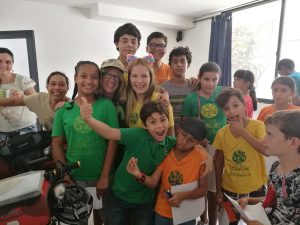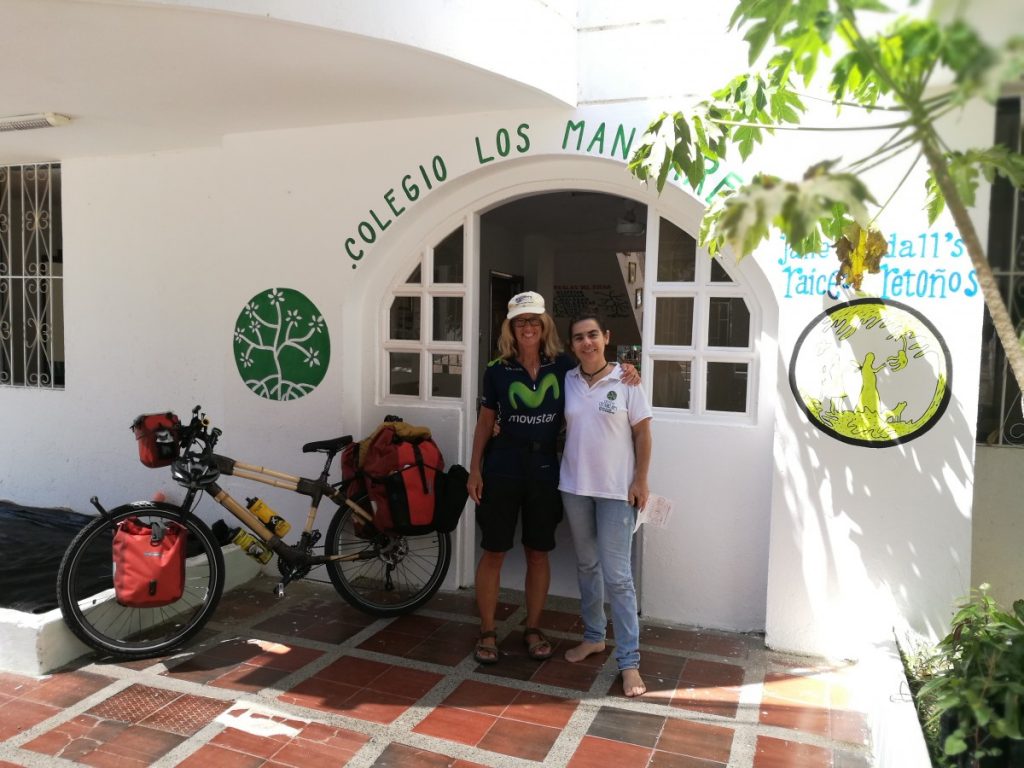‘We have to reinhabit the earth, intelligently, humanely and effectively’ wrote T.C.McLuhan in his introduction to The Way of the Earth. It’s a pretty good way to describe the work of the people and projects I’ve been lucky enough to meet in my first few weeks in Colombia.
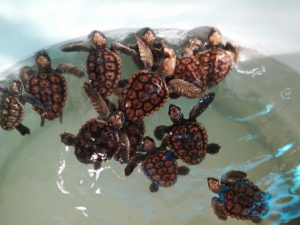 But perhaps I should start with the turtles. Juvenile, Loggerhead turtles to be precise, in an aquarium called Mundo Marina in Rodadero, Santa Marta. I had gone there to meet Calu Noriega, a marine
But perhaps I should start with the turtles. Juvenile, Loggerhead turtles to be precise, in an aquarium called Mundo Marina in Rodadero, Santa Marta. I had gone there to meet Calu Noriega, a marine 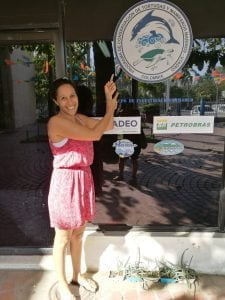 biologist working on a turtle and marine mammal protection programme. Loggerhead turtles are endangered here, and the aquarium looks after by-catch turtles that the fishermen bring in, as well as turtles the aquarium hatches from eggs and keep for a year before releasing them strong and healthy into the sea. Knowing little about turtles, I was ready for a trove of information; but I hadn’t anticipated that the turtles themselves would be so engaging. They are intelligent and inquisitive; charismatic, even. I’ve never made eye-contact with a turtle before. It was unexpectedly moving, a glimpse into a way of living both very different and very similar to our own. And they are beautiful – greens and yellows and tans in their patterned shells catching the sunlight through the water.
biologist working on a turtle and marine mammal protection programme. Loggerhead turtles are endangered here, and the aquarium looks after by-catch turtles that the fishermen bring in, as well as turtles the aquarium hatches from eggs and keep for a year before releasing them strong and healthy into the sea. Knowing little about turtles, I was ready for a trove of information; but I hadn’t anticipated that the turtles themselves would be so engaging. They are intelligent and inquisitive; charismatic, even. I’ve never made eye-contact with a turtle before. It was unexpectedly moving, a glimpse into a way of living both very different and very similar to our own. And they are beautiful – greens and yellows and tans in their patterned shells catching the sunlight through the water.
Turtles are considered an umbrella species – if you can protect them you will protect all sorts of other species too – 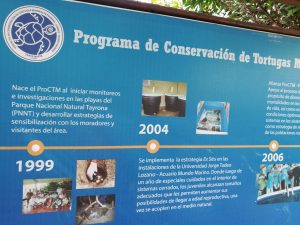 and the project works with multiple stakeholders on various levels, including the development of ‘turtle tourism’. This brings in financial support but is also educational, as visitors learn about turtle biology and the various challenges to their lives and wellbeing, and then take ‘their’ young turtle to the beach on release day. Calu and her team also work with fishermen, who they pay to protect the turtle beach, and other locals many of whom are extremely poor and eat/sell turtles for meat, eggs, the shell etc. She was optimistic about things beginning to change. ‘The fishermen are coming on-side,’ she said, ‘and other locals too. Numbers are slowly going up.’ Though given that turtles can live to be a hundred years old, monitoring turtles is a long, slow process.
and the project works with multiple stakeholders on various levels, including the development of ‘turtle tourism’. This brings in financial support but is also educational, as visitors learn about turtle biology and the various challenges to their lives and wellbeing, and then take ‘their’ young turtle to the beach on release day. Calu and her team also work with fishermen, who they pay to protect the turtle beach, and other locals many of whom are extremely poor and eat/sell turtles for meat, eggs, the shell etc. She was optimistic about things beginning to change. ‘The fishermen are coming on-side,’ she said, ‘and other locals too. Numbers are slowly going up.’ Though given that turtles can live to be a hundred years old, monitoring turtles is a long, slow process.
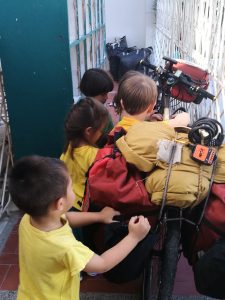 And of course, a key strand is partnership with local schools, including the one Woody and I had just visited; the very wonderful Colegio Los Manglares. I’d been invited there by Ybeth Pinzon, a colleague of a friend of a friend; and now very much a colleague and friend direct. Kids as young as one and half and as old as fourteen swamped over Woody and then listened politely – youngsters first, then the older ones – as the English teacher kindly translated my account of what we were up to. Not exactly experienced with kids, I worked away at finding (not terribly imaginative) questions they might engage with, like, ’what Colombian wild animals might I see?’ (and was a little perplexed by ‘donkeys’) but the question they most wanted to ask was my age. I’m not quite sure how to feel about the astonishment the answer (53) usually provokes, nor the inevitable follow up ‘but that’s the same as my mum/aunt/granny/great granny!’ At the end of the session they all wrote me a good luck letter, many illustrated; absolute treasures of the trip so far, though of course I can’t carry them all.
And of course, a key strand is partnership with local schools, including the one Woody and I had just visited; the very wonderful Colegio Los Manglares. I’d been invited there by Ybeth Pinzon, a colleague of a friend of a friend; and now very much a colleague and friend direct. Kids as young as one and half and as old as fourteen swamped over Woody and then listened politely – youngsters first, then the older ones – as the English teacher kindly translated my account of what we were up to. Not exactly experienced with kids, I worked away at finding (not terribly imaginative) questions they might engage with, like, ’what Colombian wild animals might I see?’ (and was a little perplexed by ‘donkeys’) but the question they most wanted to ask was my age. I’m not quite sure how to feel about the astonishment the answer (53) usually provokes, nor the inevitable follow up ‘but that’s the same as my mum/aunt/granny/great granny!’ At the end of the session they all wrote me a good luck letter, many illustrated; absolute treasures of the trip so far, though of course I can’t carry them all.
Los Manglares is the first Roots and Shoots school in Colombia, and possibly the world. Set up by the amazing and 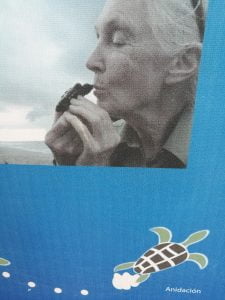 indefatigable Jane Goodall, Roots and Shoots works to develop knowledge, care and emotional connection, and action, in relation to animal welfare, environmental sustainability and human social/community issues. Each project – and there are many hundreds around the world – then chooses its own focus. Los Manglares’ is turtles and plastic. ‘Less plastic = more turtles’ is prominently inscribed, complete with papier mache turtle, on one of the main classroom walls.
indefatigable Jane Goodall, Roots and Shoots works to develop knowledge, care and emotional connection, and action, in relation to animal welfare, environmental sustainability and human social/community issues. Each project – and there are many hundreds around the world – then chooses its own focus. Los Manglares’ is turtles and plastic. ‘Less plastic = more turtles’ is prominently inscribed, complete with papier mache turtle, on one of the main classroom walls. 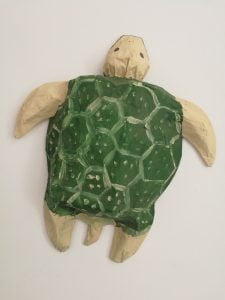 Turtles are integrated into the entire curriculum. The kids meet turtles and find out about turtles at the aquarium, and take part in turtle releases. They also do beach cleans and learn about the impact of plastic pollution – a huge issue here – on turtles and then go home and nag their parents into using less plastic and dropping less litter. Turtles are used to teach maths (how much do they weigh, how far do they swim, etc), art, reading and writing…. Each year builds on the last so you end up with a group of passionate, informed, activist kids, whose impact spills out all around them.
Turtles are integrated into the entire curriculum. The kids meet turtles and find out about turtles at the aquarium, and take part in turtle releases. They also do beach cleans and learn about the impact of plastic pollution – a huge issue here – on turtles and then go home and nag their parents into using less plastic and dropping less litter. Turtles are used to teach maths (how much do they weigh, how far do they swim, etc), art, reading and writing…. Each year builds on the last so you end up with a group of passionate, informed, activist kids, whose impact spills out all around them.
Ybeth, who everyone called by her nickname, Chili, is the co-ordinator of Roots and Shoots, Colombia. She also started and heads the school, not least because she wanted a decent, humane school for her daughter. Other key principles include a huge focus on positive feedback, and working with all aspects of childrens’ development – social, artistic, physical etc as well as intellectual; resistance to tests and a general destressing of the rote learning, test-mad approach apparently favoured by most ‘normal’ Colombian schools. (There is free basic education in Colombia but it is not always highly rated, and many people pay for their children to attend private schools if they possibly can. Which of course, many can’t.)
At Los Manglares, the kids are all treated as individuals and engaged in ways appropriate to whatever stage of learning they are at, rather than all at the same pace. One of the things I thought particularly brilliant was the way they are assessed – with the help of a tree with numerous, differently-coloured leaves. Each leaf represents a different aspect of the child’s development, such as social skills, maths, art and so on. A yellow leaf means, this aspect needs supporting. Light green means, you are well on the way; dark green, you have this sussed and red, you are above the curve. The kids all colour in their own trees, and then compare with the teachers’ version, followed by a discussion about any divergences. The net result of this and many other independent, holistic learning sort of strategies is a group of young people who have strong social skills, emotional intelligence, self-confidence, critical thinking, the ability to problem solve – and who are passionate environmentalists. ‘It’s challenging at times, Chili said. Sometimes the kids come and say, Chili, we don’t like this about our school and here is our suggestion for doing it better.’
Wow. How very, very much do we need young people to be saying that about society in general?! By the end of the afternoon I was fairly convinced that all we need to save the world is for Chili to take it over….
If you would like to find out more about the turtle project and/or make a donation, please click here: http://heroesalrescateanimal.com/portfolio/aminta-jauregui-corazon-de-tortuga/
